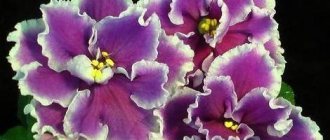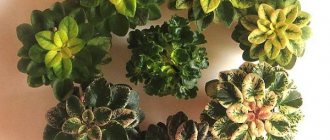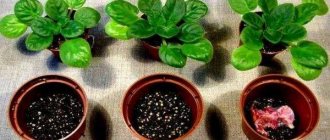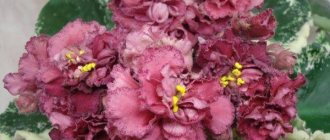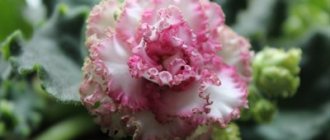In floriculture, especially for species that have many varieties (for example, there are more than 20,000 Saintpaulias), there are twin violets - when the same variety is grown simultaneously in different parts of the world and given two names.
In addition, there are varieties that are simply very similar and difficult to distinguish from each other.
Optimara Saintpaulia Crater Lake and Winter Rose are excellent examples of this similarity. Many sources say that Winter Rose is Optimar's sport, but this is not confirmed. They have such small differences that they are often confused. Below we will show you a photo and description of this wonderful variety.
Violet Winter Rose (Optimara Crater Lake) R. Holtkamp
Mysterious purple winter rose (Crater Lake Optimara) R. Holtkamp.
Both varieties belong to the hybrid genus Saintpaulia of the Gesneriev family. All data on the origin of Lake Crater Optimara is precisely known and the breeder who bred it is Hotkamp, and the variety is classified as industrial.
The breeding history of Rose is lost, as is the name of the breeder; its parameters are suitable for industrial varieties, which confirms its connection with Optimara.
The rosette is uniform, symmetrical, like all representatives of industrial Saintpaulias. Foliage:
- The average size;
- Rounded, with small teeth;
- Light green color.
The variety has medium-sized leaves.
Leaf cuttings may stretch slightly.
The flowers are pink, blue-purple in color with a gray-blue underside. The diameter of the flower is large, and the number of peduncles is quite impressive:
- Strong;
- Short;
- Stretch upwards, due to which a hat of flowers is formed.
The Winter Rose variety is considered a sport by Optimara and differs from it in several ways:
- The leaf color is darker;
- The flowers have a distinct white border;
- The underside of the petals is lighter, as is the main color of the flowers.
Saintpaulia flowers have a white-purple hue.
Attention! Some gardeners tend to think that Winter Rose is not a sport of Optimar, but simply its popular name, and the difference in appearance is explained by differences in maintenance conditions.
Optimara Millennia: description and features of the variety
Optimara Millenia was obtained back in 2001 by the nursery of Hermann Holtkamp, which is known throughout the world for its series of violets “Optimara” and “Rhapsody”. The variety, like other plants bred by the breeder, is resistant to various diseases, is distinguished by its early flowering period and compact size.
The foliage of Optimara Millenia is simple, medium green in color and well pubescent. The plates are jagged, with a pointed edge, and small in size. The rosette of this Optimara is small, which allows us to classify the variety as a small standard. The violet grows symmetrical rows of leaves that overlap each other independently, without any intervention from the collector.
The Optimara Millenia flower belongs to the pansy type, its color is quite interesting - red-crimson prints appear on a white background, located on the lower petals and complemented by a corrugated border. In rare cases, red smears may appear at the top of the bud.
Optimara Millenia produces a lot of flower stalks - it seems as if they are located throughout the rosette. The size of a fully blossomed bud is small, only 4 cm, but such “compactness” is more than compensated for by the large number of flowers. The budding period is quite long, lasting about 5-6 weeks, and after the last flowers of Optimara Millenia have dried, it blooms again after 2-4 months.
Optimara Millenia is a temperature-sensitive variety, so in hot conditions the buds float, flourishing completely red. In cool weather, the white base of the petals is more pronounced; there are often cases when the rosette reveals almost monochromatic snow-white buds with faint crimson strokes. It is important to choose the right lighting for the variety, since a lack of light will inevitably affect the quality of flowering, as will overexposure.
Optimara Millennia reproduces well - after rooting, the leaf quickly produces a large number of children. Young plants bloom on average 10 months after planting the cuttings.
Home care
Considering the external identity of both varieties as industrial, they are identical and unpretentious in care.
Conditions of detention
When choosing a place to place a flowerpot, you should consider some requirements:
- The lighting should be bright, but not in direct sunlight. Saintpaulia burns easily when the sun hits the leaves, and even the reflection of sunlight from snow in winter can cause burns;
- The temperature in winter should not fall below 16°, and in summer it should not rise above 26°;
- The recommended air humidity is 60%, while in the summer heat it is better to increase this figure slightly, and in winter to reduce it.
Attention! For this variety, it is best to withstand a slightly lower temperature, this allows you to get a light white border in Winter Rose and richer color in Optimara.
Watering, fertilizing
The plant responds well to wick watering, whereas with classical watering it grows more slowly and
the socket is more compact:
- Classic watering - water is poured into a tray or under the leaves (avoiding contact with leaves and growing points). The frequency of watering depends on the season - in the summer about once a week, in the winter a little less often;
- Wick: water is constantly in a container under the pot and the wick is lowered into it through the drainage hole. The plant independently regulates the amount of moisture it needs.
Mineral fertilizers are applied regularly; their dosage and frequency of application depend on the type of irrigation:
- For the first, the operation is carried out by watering (in the summer about once every two weeks, in the winter a little less often), the dosage is half the recommended;
- For the second, the fertilizer is constantly diluted in water, and according to the instructions, the dosage is reduced by 7-8 times.
Transplantation and rejuvenation
Most often, a rosette is replanted in the first 1.5-2 years of life, when the bush grows and the size of the pot needs to be changed regularly. Subsequent transplantations are performed when:
Violets can be replanted once a year.
- Substrate replacement;
- Deepening of the bare stem;
- And bush rejuvenation.
Methods for transplanting Saintpaulia:
- When replanting at an age, the crop is simply transferred to a new pot and sprinkled with new soil;
- When completely replacing the soil, the procedure is more complicated:
- The plant is removed from the pot and the old substrate is completely shaken;
- Clean the root system from old damaged roots;
- A new substrate is poured into the pot and the plant is planted in the center of the pot.
- For rejuvenation and deepening, the rosette is replanted, as in the previous version, but the procedure of pruning the leaves is added, they are cut high enough and the stem is buried (with the
need to shorten the stem from below.
In addition to pruning for rejuvenation, it is also carried out for hygienic purposes. In this case, if necessary, remove old leaves and peduncles.
Land for Saintpaulia consists, depending on the type of irrigation:
- For the classics, peat, soil and perlite are taken in equal parts and 0.3 moss is added;
- For the wick, only peat and perlite are used in equal proportions.
Reproduction
The absence of a chimeric pattern on the flowers and variegation on the leaves allows the variety to reproduce in any known way:
- Leafy - a cut is taken from 2-3 rows, rooted in a convenient way (in water, soil or moss), after the children appear, they are grown and planted. In addition, care is identical to adult plants;
- Stepson - you can plant an adult specimen that has its own roots, or cut and root leaf cuttings using one of the rooting methods;
Most often, Saintpaulias are propagated from leaves.
- The stem is a complex method, it is used very rarely, because the fresh stem takes root in the soil under the film;
- Seeds - this method is most often propagated with new varieties, and for breeding this method is too unstable in terms of transfer of maternal data.
Reviews
Anastasio. “I purchased Saintpaulia Optimara Crater Lake and after flowering I noticed some inconsistencies in appearance. I started researching and discovered that I had a sport called Winter Rose. Honestly, the grip is even better than I expected. The graceful edges along the edges of the petals of the small roses against the background of dark leaves are simply mesmerizing.”
This variety attracts with unusual flowers.
Irina. “I was looking for Winter Rose for a long time, it turned out that my friend had the Optimara crater lake and she said it was the same. After flowering I was a little disappointed, there is no white border, although the shape of the flowers and color are more or less what I wanted. The investigation continued, and the friend claims that this is due to other conditions of detention.
I tried everything, let it cool, increased the humidity and decreased the light, no result, so I think they are still two different varieties and I'm looking for Rose."
Features of flowering, growth and reproduction
The varieties grow quite quickly, but the first flowering is expected in about a year. The rosette forms independently and also produces a fairly uniform and symmetrical bush on window sills.
Reproduction of this Saintpaulia is not difficult, since there are no external factors that exclude some methods.
The plant blooms profusely regardless of conditions. The peduncles are quite thick, uniform, raised above the foliage, forming a beautiful cap with almost every flowering.
Attention! The Winter Rose variety has a tendency for flower stalks to fall onto the leaves, but this process is not regular.
Precious stones last a very long time. It may take two weeks from full bloom to drying of the flower, but this is the average.
Depending on the temperature conditions, the color may vary slightly:
- In cooler conditions, the contrast between the height and underside of the petals is much greater;
- And the heat makes the inside darken.
Review of individual varieties and their photos
There are many known industrial varieties of Optimara violets . All Saintpaulias presented in production differ significantly from each other in color, shape and size.
- Violets optimara my love.
- Optimara my desire.
- Optimara ever precious.
- "Optimara may dream."
- "Optimara Michigan" of British selection.
Attention : A neat rosette is formed by medium-sized leaves. The sheets are laid next to each other like tiles, so the rosette is formed very compact and does not take up much space.
The violet blooms with large flowers of various colors. They are usually decorated with a spot of contrasting color. The yellow stamens add charm to this flower. The flower stalks are very strong, each of them forms 5-6 buds .
My love
It has light green leaves. Violet flowers have a white tint. They are decorated with a contrasting inky purple spot. A special feature is that in warm weather the flowers become almost completely inky purple, and only the tips of the petals are white.
And in cool weather, violet forms almost white flowers . And in the center of the flower there remains a small inky purple eye with yellow stamens.
We recommend watching a video about the Optimara violet variety “My love”:
My desire
It has two-tone white flowers with a deep pink center. The foliage is medium green in color. The leaves are slightly toothed and heart-shaped.
Ever precious
It is endowed with white flowers with a red-violet border on the lower three petals and blue on the upper two in combination with a green corrugated border. The violet flowers themselves are simple, semi-double, slightly ruffled . The foliage is green, glossy, frilly, slightly wavy.
May dream
A variety from the my Violet series. It has huge simple cup-shaped flowers that look like stars. And in the center there is a bright blue-violet eye. Flowers grow up to 7 cm. They retain their cup-shaped shape for a long time, then open.
Flowers of 2-4 pieces are on short strong peduncles. The flowering is rich and lasts a long time. The foliage is simple quilted and has a medium green color. The reverse side of the sheet is painted red.
The beautiful, quilted, medium green leaves create a perfect flat, even rosette . This allows large white flowers to look great against its background.
We recommend watching a video about the Optimara violet variety “myDream”:
Michigan
Endowed with flowers of a very delicate light pink color. Its flowering is rich and resembles a hat. The leaves are a beautiful green color. On the reverse side they have a red tint. The socket is standard, compact.
" Greenhouse effect", bright "Chanson" and exquisite "Blue Fog".

